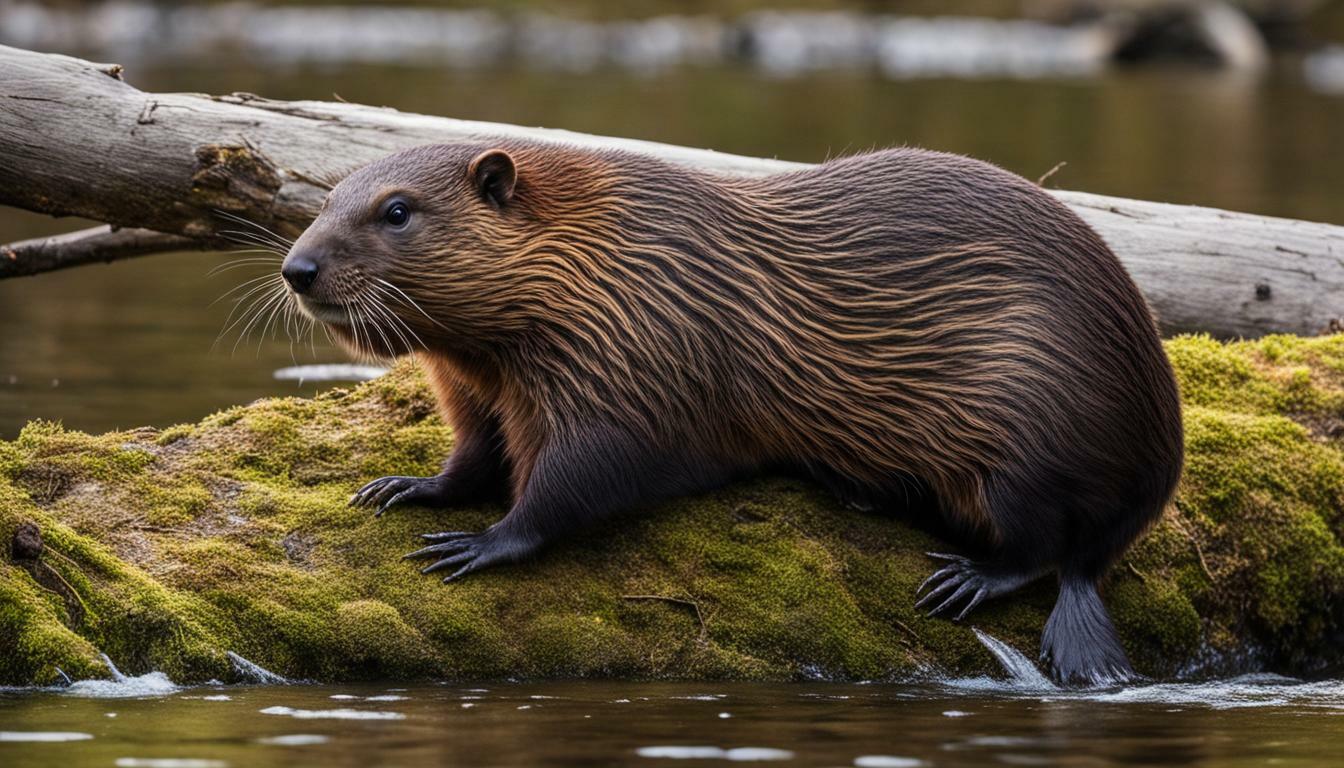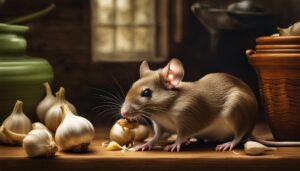Beavers are fascinating creatures known for their impressive engineering skills, but can they jump? In this article, we delve into the question of whether beavers have the ability to jump. We will explore their anatomy, behavior, and limitations to understand their jumping abilities. Let’s uncover the truth about beavers and their vertical movement.
Key Takeaways:
- Beavers cannot jump or climb well due to their hind leg structure and heavy body.
- They have webbed feet on their back legs for swimming, but lack the strength in their front legs for holding onto branches.
- While beavers may do small shuffles or hops, they are not capable of jumping or springing in the air.
- Beavers’ main ability lies in the water, where they are agile swimmers.
- They use their sharp claws to grasp onto trees while in the water, but their hind legs are not adapted for climbing.
Now that we have a glimpse of what to expect, let’s dive deeper into the fascinating world of beavers and explore their jumping abilities.
Understanding Beaver Anatomy
To understand if beavers can jump, it’s important to examine their unique anatomy and how it influences their movement. Beavers have a distinct body structure that limits their ability to perform jumping or climbing behaviors. Their hind legs are specifically adapted for swimming, with webbed feet that enable them to navigate through water with ease.
While beavers may do small shuffles or hops, they lack the physical capabilities to jump or spring in the air like other animals. Their hind legs are powerful and provide the necessary propulsion for swimming, but they are not designed for vertical movement or jumping off the ground. Additionally, beavers have a heavy body due to their dense fur and build, further limiting their ability to perform such movements.
Beavers’ front legs, although strong, do not possess the necessary strength to hold onto branches or surfaces while in the air. They primarily rely on their sharp claws to grasp onto trees while in the water, using their body weight and leverage to access the branches they need. However, their hind legs are not adapted for climbing like those of other animals, which further highlights their limitation in vertical movement.
| Beaver Anatomy | Features |
|---|---|
| Hind Legs | Adapted for swimming with webbed feet |
| Front Legs | Strong but lack the strength for jumping or climbing |
| Body Weight | Heavy due to dense fur and build |
| Claws | Used to grasp onto trees while in the water |
In conclusion, while beavers possess remarkable swimming abilities and adaptations for aquatic life, they are not capable of jumping or climbing in the same way as other animals. Their unique anatomy, particularly their hind leg structure and heavy body, limits their vertical movement. However, beavers are expert swimmers and use their sharp claws to grasp onto trees while in the water, enabling them to thrive in their natural habitat.
Beavers’ Limited Vertical Movement
Beavers’ hind leg structure and heavy bodies restrict their vertical movement, making jumping a challenge for these industrious creatures. Their hind legs are shorter and less developed compared to their strong front limbs, which are better suited for digging, swimming, and manipulating objects.
Due to their anatomy, beavers lack the ability to jump or spring into the air like other animals. Their hind legs do not possess the necessary strength and agility for propelling themselves off the ground. Instead, they rely on shuffling or small hops while on land.
Beavers are known for their exceptional swimming skills and are most adept in the water. Their webbed feet, coupled with the sleek shape of their bodies, allow them to move swiftly and smoothly through lakes, rivers, and streams. They can use their sharp claws to grasp onto trees while in the water but are not capable of climbing trees like some other mammal species.
While beavers may occasionally be observed climbing short distances to reach plants they want to eat or to access other objects, such instances are the exception rather than the norm. Their primary mode of movement is in the water, where they can efficiently navigate and access the resources they need to survive.
| Fact | Description |
|---|---|
| Vertical Movement | Beavers have limited vertical movement due to their hind leg structure and heavy bodies. |
| Jumping Ability | Beavers cannot jump or spring into the air due to the lack of strength and agility in their hind legs. |
| Water Expertise | Beavers are agile swimmers and navigate bodies of water with ease, using their webbed feet and streamlined bodies. |
| Tree Grasping | Beavers can use their sharp claws to grasp onto trees while in the water. |
| Climbing Skills | Beavers have limited climbing abilities and are not adapted for climbing trees. |
Beavers’ Expertise in Water
While beavers may not excel at jumping, they are truly masters of the water. Their webbed feet and streamlined bodies make them extremely agile swimmers. In fact, beavers are known for their ability to construct elaborate dams and lodges in water bodies. They use their strong front legs and sharp claws to manipulate and move branches to build these structures.
When it comes to navigating through water, beavers effortlessly glide through with grace. Their hind legs, which are adapted for swimming, provide them with the propulsion they need to move swiftly. The webbing between their back toes helps them paddle efficiently, allowing them to swim both on the surface and underwater.
Beavers also use their exceptional swimming skills to their advantage when it comes to foraging for food. They can dive underwater and stay submerged for several minutes, allowing them to access vegetation and roots that may be out of reach for other animals. Their ability to grasp onto trees while in the water gives them the advantage of reaching branches that hang over the water.
Beavers’ Adaptation for Reaching Food
One of the key ways beavers make use of their limited jumping abilities is for accessing food. While they may not be able to jump high or far, they can do small shuffles or hops to reach plants or objects they need. These small movements, combined with their sharp teeth and strong front legs, enable them to reach vegetation near the water’s edge or objects floating on the surface.
Beavers’ adaptation for reaching food goes beyond just jumping. They also use their powerful jaw muscles to cut down trees and shrubs, creating a food supply that they can store and consume during the winter months. Their front teeth, which never stop growing, allow them to continuously gnaw through tough plant material.
| Beavers’ Jumping Abilities | Beavers’ Swimming Abilities |
|---|---|
| Limited vertical movement | Exceptional agility in water |
| Not capable of jumping or springing in the air | Effortless gliding and diving underwater |
| Small shuffles or hops to reach food | Webbed feet and strong hind legs for propulsion |
| Use front teeth and strong front legs to manipulate branches | Ability to grasp onto trees while in the water |
Beavers’ Ability to Grasp onto Trees
Although beavers may not jump, they have developed a remarkable ability to hold onto trees using their sharp claws. This adaptation allows them to navigate their environment efficiently and access food sources, even in challenging conditions.
Beavers’ sharp claws on their front paws provide them with a firm grip on tree trunks and branches. This enables them to stay in place while they chew through wood or build dams. Their strong front legs also assist in maintaining balance and stability while working on these tasks.
When it comes to foraging for food, beavers rely on their tree-holding skills to reach plants that are otherwise out of their reach. They can use their claws to anchor themselves to a tree while stretching their bodies to access foliage or twigs. This allows them to satisfy their dietary needs without the need for jumping or climbing.
| Beavers’ Tree-Holding Abilities | Summary |
|---|---|
| Sharp Claws | Beavers have sharp claws on their front paws that enable them to firmly grasp trees and branches. |
| Balance and Stability | Their strong front legs help them maintain balance and stability while working on tasks that require tree holding, such as chewing wood or building dams. |
| Access to Food | Beavers use their tree-holding abilities to reach plants and twigs that would otherwise be inaccessible, allowing them to meet their dietary needs. |
Overall, while beavers may not possess the ability to jump or climb well, their expertise in grasping onto trees with their sharp claws is truly remarkable. This adaptation allows them to thrive in their natural habitat and fulfill their ecological role as builders and engineers of the natural world.
Beavers’ Limited Climbing Skills
When it comes to climbing, beavers face some challenges due to their hind leg structure, but there are certain situations where they may climb short distances. The hind legs of beavers are designed for swimming, with strong webbed feet that allow them to navigate through water effortlessly. However, their hind legs are not adapted for climbing trees or jumping over obstacles like some other animals.
Beavers primarily rely on their swimming abilities to move around, using their powerful front legs and webbed feet to propel themselves through the water. Their front legs are equipped with sharp claws that enable them to grasp onto branches while in the water, supporting their movement and stability.
While climbing is not their strong suit, there are instances where beavers have been observed climbing short distances. These situations usually involve reaching plants they want to eat or accessing objects like stairs or small piles of debris. In such cases, beavers may use their front legs and claws to pull themselves up or maneuver over obstacles, but they are not known for scaling trees or performing impressive jumps.
Examples of Beavers’ Climbing Behaviors
Although beavers are not exceptional climbers, they possess some level of adaptability when it comes to overcoming obstacles. For example, if there is a fallen tree blocking their path in the water, beavers may climb over it by leveraging their front legs and body weight to push themselves up and over the obstacle. This technique allows them to continue swimming along their intended route, without the need for an elaborate jumping or climbing action.
| Beavers’ Climbing Behaviors: | Description: |
|---|---|
| Short-distance climbing | Beavers may climb short distances to reach plants or objects they need. |
| Fallen tree climbing | Beavers can climb over fallen trees in the water using their front legs and body weight. |
| No tree climbing ability | Beavers are not adapted for climbing trees. |
In summary, while beavers face limitations in their climbing skills due to their hind leg structure, they have developed unique ways to overcome obstacles in their environment. Their main strength lies in their swimming abilities and their sharp claws, which allow them to grasp onto objects while navigating through water. While they may perform small climbs or shuffles, beavers are not capable of impressive jumps or climbing trees like other animals.
Observations of Beavers Climbing
While not known for their climbing abilities, there have been observations of beavers climbing short distances in certain situations. This behavior is typically seen when beavers need to reach plants they want to eat or when they encounter obstacles such as stairs or small piles of debris.
Beavers primarily use their sharp claws and strong front legs to hold onto branches while in the water. However, in instances where their desired food or object is just out of reach, they may resort to climbing to achieve their goal.
It is important to note that beavers’ hind legs are not adapted for climbing and they do not have the ability to jump or spring in the air. Their limited climbing skills are restricted to shorter distances and specific circumstances.
| Observations of Beavers Climbing | Summary |
|---|---|
| Beavers may climb short distances | Beavers climb when faced with obstacles or to reach desired food/objects beyond their usual reach |
| Behavior seen in certain situations | Climbing behavior is observed in specific circumstances, not as a common trait |
| Hind legs not adapted for climbing | Beavers’ hind legs are not well-suited for climbing, limiting their climbing ability |
In conclusion, while beavers are not known for their climbing abilities, they have been observed climbing short distances under certain conditions. This behavior is a means for them to overcome obstacles or reach food and objects beyond their normal reach. However, their hind legs are not adapted for climbing, and their climbing skills are limited compared to other animals. Beavers’ main strengths lie in their swimming capabilities and their ability to manipulate their environment to suit their needs.
Beavers’ Adaptation for Reaching Food
Although beavers may not be natural jumpers, they have found ways to adapt their movements to reach the food they rely on. Due to their hind leg structure and heavy bodies, beavers are not capable of jumping or climbing well. However, when it comes to accessing plants or other objects they need, they have developed unique strategies.
Beavers primarily rely on their expert swimming skills to navigate their aquatic environment. They use their webbed feet on their back legs for propulsion and control in the water, allowing them to move swiftly. While swimming, beavers can also use their sharp claws to grasp onto trees, holding onto branches for stability or reaching vegetation that grows near the water’s edge.
In certain situations, beavers have been observed climbing short distances to access desired food sources. While this behavior is not common, it demonstrates their ability to adapt their movements. Beavers may use nearby obstacles like stairs or small piles of debris as stepping stones, propelling themselves forward with small shuffles or hops. However, it’s important to note that beavers are not known for climbing trees or jumping over significant obstacles.
| Beavers’ Adaptation for Reaching Food |
|---|
| Beavers rely on their swimming abilities to access food. |
| They use their webbed feet to propel themselves in the water. |
| Beavers can grasp onto trees with their sharp claws. |
| In certain instances, they may climb short distances. |
| Beavers are not natural jumpers or climbers. |
In summary, while beavers may not possess the jumping abilities of other animals, they have successfully adapted their movements to reach the food they require. By utilizing their swimming skills, webbed feet, and sharp claws, beavers can maneuver through their aquatic habitats and grasp onto objects to fulfill their nutritional needs.
Beavers and Overcoming Obstacles
While beavers may not jump over obstacles, they have developed unique methods to overcome challenges they come across. Due to their hind leg structure and heavy body, beavers are not well-suited for jumping or climbing. However, they have evolved specific adaptations that allow them to navigate their environment effectively.
One of the main strategies beavers employ to overcome obstacles is their ability to manipulate their environment. They are known for their impressive dam-building skills, using sticks, branches, and mud to construct barriers in bodies of water. These dams serve multiple purposes, including raising the water level to create a safe habitat and provide protection from predators. By altering their environment, beavers can create pathways and navigate around potential obstacles.
In addition to dam-building, beavers use their strong front teeth to fell trees and build lodges. These structures not only provide shelter but also assist in overcoming obstacles. Beavers build their lodges near the water’s edge, ensuring easy access to their food source and minimizing the need to navigate difficult terrain. The trees they fell often serve as stepping stones or natural ramps, allowing beavers to traverse obstacles that would otherwise impede their movement.
| Beaver Obstacle Navigation Strategies |
|---|
| Dam-building to create pathways and bypass obstacles |
| Using felled trees as natural ramps or stepping stones |
| Building lodges near the water’s edge for easy access to food and minimizing difficult terrain |
While beavers may not possess the jumping and climbing abilities of other animals, they have honed their techniques for overcoming obstacles through their environmental modifications and construction skills. Their resourcefulness and adaptability allow them to thrive in their aquatic habitats, where their main abilities lie.
Beavers’ Main Skills in Summary
In summary, while beavers have many impressive skills, jumping is not one of their main abilities. Due to their hind leg structure and heavy body, beavers cannot jump or climb well. Instead, they excel in the water, where their agility as swimmers is unmatched. Beavers have webbed feet on their back legs, which enable them to navigate through water with ease.
Although beavers may do small shuffles or hops on land, they are not capable of jumping or springing in the air like other animals. Their hind legs are not adapted for climbing, making it difficult for them to scale trees or overcome high obstacles. However, in certain situations, beavers may be observed climbing short distances to reach plants they want to eat or to access other objects like stairs or small piles of debris.
Beavers’ main adaptation for movement is in the water, where their natural habitat lies. They use their sharp claws to grasp onto trees while in the water, allowing them to secure their position and manipulate branches. This skill is crucial for building their lodges and dams, as well as for accessing food sources that are near the water’s edge.
| Beavers’ Main Skills: |
|---|
| Agile swimmers |
| Webbed feet for swimming |
| Limited jumping and climbing abilities |
| Sharp claws for grasping onto trees in the water |
| Can climb short distances in certain situations |
Conclusion
In conclusion, beavers are not known for their jumping skills, but their expertise lies in their remarkable engineering abilities and agility in the water. The hind leg structure and heavy body of beavers prevent them from jumping or climbing well. With webbed feet on their back legs, they are skilled swimmers, using their strong tails to navigate through the water. While beavers may do small shuffles or hops, they lack the ability to jump or spring in the air like other animals.
Beavers’ main adaptation for mobility is in the water, where they are highly skilled and can move with precision. They utilize their sharp claws to grasp onto trees while in the water, allowing them to manipulate and transport branches for dam construction and food collection. However, their hind legs are not adapted for climbing, limiting their ability to ascend vertical surfaces or trees.
While beavers may occasionally be observed climbing short distances to reach plants they want to eat or to access other objects like stairs or small piles of debris, they are not known for climbing trees or jumping over obstacles. Their main focus is on the construction and maintenance of their aquatic habitats.
Overall, the incredible adaptability and resourcefulness of beavers make them fascinating creatures to study. Although they may not possess the ability to jump like other animals, they excel in their aquatic environment, where they are vital for ecosystem balance and demonstrate their exceptional engineering skills.
FAQ
Can beavers jump?
No, beavers cannot jump due to their hind leg structure and heavy body. They do not have the strength in their front legs to hold onto branches and lack the ability to leap into the air.
Do beavers have the ability to climb?
Beavers are not known for their climbing skills. While they may occasionally climb short distances to reach plants or access other objects, their hind legs are not adapted for climbing trees or jumping over obstacles.
Why can’t beavers jump or climb well?
The hind leg structure and body weight of beavers make jumping and climbing difficult for them. Their main expertise lies in the water, where they are agile swimmers due to their webbed feet and use their sharp claws to grasp onto trees while underwater.
Can beavers hop?
Beavers may do small shuffles or hops, but they are not capable of jumping or springing in the air like other animals. Their limited vertical movement restricts their ability to hop significant distances.
How high can beavers jump?
Beavers cannot jump to any significant height. Their anatomy and body weight do not allow for powerful leaps.
How do beavers overcome obstacles?
Beavers primarily rely on their swimming skills and adaptations for underwater movement to overcome obstacles. They may use their limited jumping abilities to access plants or other objects they need.
Can beavers leap?
No, beavers do not have the ability to leap like other animals. Their hind leg structure and heavy body weight prevent them from performing leaps or jumps.
Why are beavers expert swimmers?
Beavers are expert swimmers due to their webbed feet on their back legs and their strong swimming muscles. They are well-adapted for moving through water and rely on this skill for their survival.
Are beavers known for climbing trees?
No, beavers are not known for climbing trees. Their hind legs are not structured for climbing, and they primarily rely on their swimming and grasping abilities to navigate their environment.
Can beavers jump over obstacles?
Beavers are not known for their jumping abilities and cannot jump over obstacles like other animals. They have limitations in their vertical movement and are better adapted for swimming and maneuvering in water.




